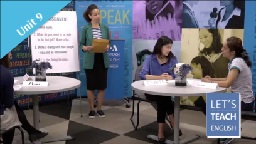 Unit 9: English for Specific Purposes and Vocational Language Unit 9: English for Specific Purposes and Vocational Language
In this lesson, students work on an independent project.
Each student researches a job and creates an interview
dialog for someone trying to get that job. During class,
the students practice their interview role-plays with
one another. Then, they perform them with partners for
other students in a small group. |
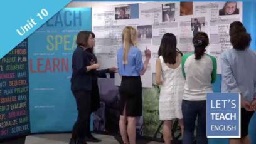 Unit 10: Collaboration Unit 10: Collaboration
In this lesson, students learn how to write a poem. They
use a format the teacher calls a “persona poem.”
Students ask each other questions. The answers to those
questions become the poem. Students learn that not all
poems have to rhyme. |
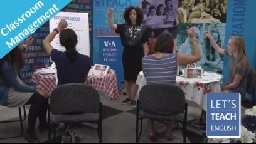 Teacher Resources Examples of Classroom Management Teacher Resources Examples of Classroom Management
In this final appearance of Let's Teach English, we
present a collection of classroom management tools for
teachers as well as the complete set of teacher and
students texts. |
|
|
 Transcript Transcript
The following is the transcript of the introduction video at the top of the
page. |
|
|
Tra Mi: You have been watching the videos. Your assignment was to choose a
teaching topic, explain it in your own words, and give an example of where
you see it in the video course. Can you tell me what you chose?
Rebecca Sui: I chose Constructivism.
Linh Dan: Mine is about the Communicative Language Teaching Method.
Laila Azimi: I looked for some Learner-Centered Practices, such as teaching
students how to use learning strategies.
Tra Mi: Very good. Since Let’s Teach English is built on the theory of
Constructivism, why don’t you start?
Rebecca Sui: Sounds good to me!
Rebecca Sui: When I think of building or “constructing” something, I see a
house or a school. To me, constructivism means my students are taking in new
ideas and new words, and building their own understanding of the world
around them.
I found an example of this in Unit 4.
First, the teacher prepares students to read a story by talking about the
content. She has her students bring in pictures of technology that they know
about. In this way, students start with things they already know about. Then
they can connect that to the new information in the story. The teacher gets
her students interested in the story by previewing the title and images.
Rebecca Sui: The students know about technology and the internet. But, they
do not know that someone could learn from the internet without having an
internet connection. They read a story and learn about a mobile library
called SolarSPELL, where information from the internet could be stored.
Finally, her students make a picture to explain the SolarSPELL library in
their own words.
Rebecca Sui: I think this is a good example. They knew something to start
with, but they had to construct or build on their knowledge. They read about
the Solar SPELL and then they told about it in their own words. They learned
some new words in English and they also learned about a new place, Vanuatu.
Tra Mi: Okay, great start on constructivism. Who wants to talk next?
Linh Dan: I do! I decided to talk about the Communicative Language Teaching
method.
Linh Dan: In Unit 5, the students do role-plays in groups, and each group
has different information. That way, their role plays are all different.
This is a great example of a real world task and Communicative Language
Teaching. Students use their own words to shop, sell, and bargain in the
marketplace.
Video clip of shopping role play
Linh Dan: The students were in a real-world situation in this unit. They
were using English in a meaningful way to do the task. They had a clear
purpose for communicating. And, just as important, the activity was
learner-centered because they had choices in the language and actions that
they used.
Tra Mi: Thank you, Linh Dan! Now, for Layla’s presentation.
Laila Azimi: I want to tell you what I learned about Learner-Centered
Teaching and Active Learning for students. In Unit 9, the students practice
an interview for a job. They each choose the job that they want to get.
Then, they practice the learning strategy of “predicting” in two ways. They
predict what kinds of questions can occur in their interviews. And, during
the role-play, the listening group predicts what questions might come next.
Laila Azimi: We saw one student’s interview for the job she chose. We know
that every student chose a different job, did research about that job, and
wrote her own interview questions.
Tra Mi: What was the teacher’s role in this?
Laila Azimi: The teacher’s job was to support the learners in their choices
and research. She also gave them more control over their learning by
teaching them to apply strategies. In this case, they predicted hard
questions for the interview. They can use these strategies later in other
real-world situations.
Tra Mi: Thank you, all, for sharing these important topics of language
teaching:
Constructivism
Communicative Language Teaching
Learner-Centered Practices and Active Learning
Tra Mi: So, let’s start with the first unit!
Laila Azimi, Linh Dan, and Rebecca Sui: Yes, let’s teach English together!
© 2017 University of Oregon and Voice of America. This work is based on the
Women Teaching Women English materials
produced by the University of Oregon American English Institute under U.S.
Department of State Federal Assistance Award
S-LE200-10-GR-050, issued by the U.S. Embassy Beirut. |
|
|
 Women
Teaching Women English Women
Teaching Women English
Women Teaching Women English. A collection of lessons
focusing on different topics. Fantastic activities for
English reading practice and for learning new
vocabulary. |
|
|
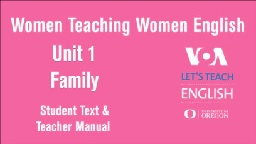 Unit
1 Unit
1
Women Teaching Women English.
This unit focuses on family and has 25 pages of
English activities and reading materials.
Click
for the full PDF lesson -
opens in a new window. |
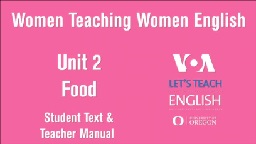 Unit
2 Unit
2
Women Teaching Women English.
This unit focuses on food and has 15 pages of
English activities and reading materials.
Click
for the full PDF lesson -
opens in a new window. |
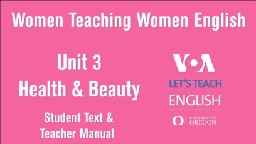 Unit
3 Unit
3
Women Teaching Women English.
This unit focuses on health and beauty and has
21 pages of English activities and reading materials.
Click
for the full PDF lesson -
opens in a new window. |
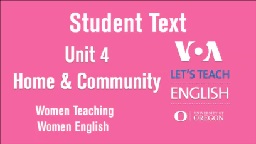 Unit
4 Unit
4
Women Teaching Women English.
This unit focuses on home and community and has
26 pages of English activities and reading materials.
Click
for the full PDF lesson -
opens in a new window. |
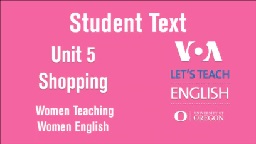 Unit
5 Unit
5
Women Teaching Women English.
This unit focuses on shopping and has 27 pages
of English activities and reading materials.
Click
for the full PDF lesson -
opens in a new window. |
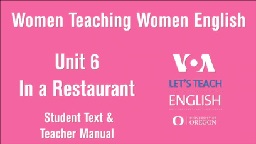 Unit
6 Unit
6
Women Teaching Women English.
This unit focuses on restaurants and has 20
pages of English activities and reading materials.
Click
for the full PDF lesson -
opens in a new window. |
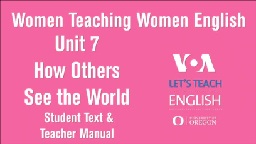 Unit
7 Unit
7
Women Teaching Women English.
This unit focuses on how others see the World
and has 31 pages of English activities and reading
materials.
Click
for the full PDF lesson -
opens in a new window. |
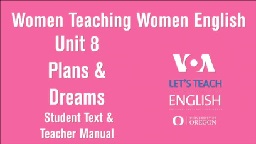 Unit
8 Unit
8
Women Teaching Women English.
This unit focuses on plans and dreama and has 25
pages of English activities and reading materials.
Click
for the full PDF lesson -
opens in a new window. |
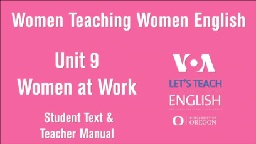 Unit
9 Unit
9
Women Teaching Women English.
This unit focuses on women at work and has 18
pages of English activities and reading materials.
Click
for the full PDF lesson -
opens in a new window. |
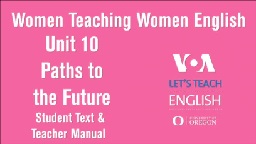 Unit
10 Unit
10
Women Teaching Women English.
This unit focuses on paths to the future and has
23 pages of English activities and reading materials.
Click
for the full PDF lesson -
opens in a new window. |
|
|
|
© 2017 University of Oregon and Voice of America. This work is based on the
Women Teaching Women English materials produced by the University of Oregon
American English Institute under U.S. Department of State Federal Assistance
Award S-LE200-10-GR-050, issued by the U.S. Embassy Beirut. |